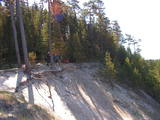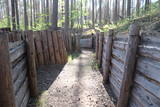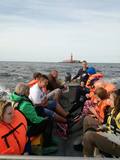| Nr | Nosaukums | Apraksts |
|---|---|---|
|
Viena no ciema augstākajām būvēm. Koka vējdzirnavas cēla 1930. g. un ar vēja palīdzību darbināja septiņus gadus (vēlāk ar elektromotoru). Pie dzirnavām atrodas Jūrmalciema tūrisma informācijas punkts, stends un atpūtas vieta. Turpat redzami veco, zvejnieku pamesto liellaivu koka korpusi. |
||
|
Radošajā mājā biedrība „Baltaine” organizē seminārus, kursus un nodarbības par latviešu gadskārtu svētkiem, ģimenes godiem, rīko kulinārā mantojuma meistarklases, kā arī mūzikas instrumentu spēli un rāda dažādus rokdarbus – pīšanu, adīšanu, tamborēšanu un šķeterēšanu. Saimnieces gatavo gardas putras, zupas, zāļu tējas, cigoriņu kafiju un cep plātsmaizes un pīrāgus. Te var mācīties dančus, iet rotaļās un dziedāt. Piedāvā kāzu uzvedumus. |
||
|
Uzņēmumam ir vairāk kā 40 gadus ilga darbības vēsture. Mūsdienas tas kļuvis par Baltijas mēroga konkurētspējīgu piena pārstrādes uzņēmumu, kur ražo pienu, kefīru, biezpienu, jogurtu, sviestu, sierus u.c. piena pārstrādes produktus. Produkciju var iegādāties uzņēmumam blakus esošajā veikalā. Viens no pieciem Latvijas uzņēmumiem, kas drīkst ražot ES garantēto tradicionālo īpatnību produktu - „Jāņu sieru”. |
||
|
No Kronvaldu Ata (1837. – 1875.) – izcilā latviešu publicista, pedagoga un valodnieka dzimtajām mājām – „Lejas Miķiem” Priekules novada Krotē nekas līdz mūsdienām vairs nav saglabājies. Māju vietā uzstādīta piemiņas plāksne ar uzrakstu: „Katram tā vieta svēta, kur piedzimis, audzis” (A. Kronvalds). |
||
|
Brīvdienu māja "Jasmīnu nams" atrodas pie pašas Jelgavas robežas - tikai 7 minūšu braucienā līdz pilsētas centram. Brīvdienu māja ir lieliska vieta mierpilnam dabas baudījumam, kas rit roku rokā ar iespēju stiprināt veselību pirtī vai alternatīvā SPA - āra kublā. Brīvdienu mājā ir 3 istabas, savrupa teritorija vienai līdz divām mājsaimniecībām – līdz 6 personām, īpašu uzsvaru liekot uz atpūtu kopā ar bērniem. Nav paredzēts skaļām ballītēm un jauniešu tusiņiem. Namiņā ir viss nepieciešamais maltītes pagatavošanai gan iekšā, gan ārā svaigā gaisā. Tuvumā atrodas Svētes upe un atpūtas zona - Svētes palienes pļavu koka laipu celiņu tīkls. |
||
|
Apskatāmi ~ 30 sugu un tikpat daudz dažādu šķirņu putni un dzīvnieki - dzērves, fazāni, gulbji, punduraitas, pundurcūkas, ķenguri, vāveres u.c. Ekskursija un stāstījums par dzīvniekiem un individuāla pastaiga pa dārzu. Iespējama retu un eksotisku augu stādu iegāde no kolekcijas dārza. |
||
|
Restorāns "Olīve" atrodas Liepājas dienviddaļā. Restorānam ir „atvērta” tipa virtuve, kur klienti var vērot pavāru darbošanos. Latviešu virtuve: baraviku zupa, zivju zupa, plānas un kartupeļu pankūkas, jēra karbonāde, grillēta cūkgaļas fileja, tvaicēta teļa mēle, jēra stilbiņš, biezpiena kārtojums. Īpašais ēdiens: mencu zupa „Olīves” gaumē vai īpašā saldējuma kūka. |
||
|
18. – 19. gs. izveidojies muižas ēku komplekss ar pagasta muzeju un spirta fabriku. |
||
|
Atrodas Jūrmalciema austrumdaļā. Koka šķūnī sakrāti vietējo entuziastu savāktie Jūrmalciema iedzīvotāju sadzīves priekšmeti un amata rīki. Novadpētnieki te var uzzināt vērtīgu informāciju par ciema vēsturi un zvejnieku dzīvesveidu. |
||
|
Baltijā vienīgais šāda mēroga brīvdabas muzejs (dibināts 1999. g.), kura eksponāti (t.sk. – monumentāli pieminekļi) atspoguļo padomju ideoloģiju. Minizoo. |
||
|
Dabas parks aptver Baltijas jūras piekrastes un jaunizveidotās aizsargājamās jūras teritorijas “Nida – Pērkone” daļu ar savulaik kustīgām, bet mūsdienās apstādinātām un aprimušām smilšu kāpām, kas tiek uzskatītas par augstākajiem Latvijas piekrastes kāpu veidojumiem. Šejienes vērtības ir arī Baltijas jūras krasta ainavas, smilšainās pludmales un nelielie zvejniekciemi. Dabas parka apskates nolūkos – Pūsēnu kalnā (viena no augstākajām Latvijas kāpām) izveidota dabas taka.
|
||
|
„Smiltenes piens” lepojas ar vairāk kā 100 gadus ilgu vēsturi. Šobrīd uzņēmums ir trešais lielākais siera ražotājs un sestais lielākais piena pārstrādes uzņēmums Latvijā. Sadarbojas ar ~ 150 kvalitatīva Latvijas piena piegādātājiem. „Smiltenes piens” ir vienīgais, kur ražo „Latvijas sieru”. Uzņēmuma produkti ieguvuši „Zaļo karotīti”. Produkciju eksportē uz 5 pasaules valstīm. Produktus var iegādāties „Smiltenes piena” veikalā Smiltenē, kas atrodas netālu no uzņēmuma. |
||
|
Atrodas 1,3 km ziemeļrietumos no Aknīstes centra, nelielā Dienvidsusējas sānu gravā. Šis avots kā veselības avots pazīstams jau kopš seniem laikiem. Stāsta, ka šādu avotu, kas izplūst uz austrumiem, ūdens ir dziedinošs. Īpaši Lieldienu rītā, ja tajā mazgā acis. Avota ūdeņi satur dzelzs savienojumus, par ko liecina brūnās nogulsnes (dzelzs baktēriju darbības rezultāts). Blakus avotam ir akmens ar nelielu iedobumu, domājams – sens kultakmens. Savukārt, gravas malā aug svētliepa. Saltupju svētavotu var pamatoti uzskatīt par vienu no izcilākajiem Latvijas avotiem. Saltupju Svētavots ir ūdeņiem tik bagāts, ka izveido nelielu upīti – Saltupi, kas pēc aptuveni simts metriem ietek Dienvidsusējas upē, avots uzskatāms par vienu no garākajiem pazemes avotiem Latvijā. Tas ir vietējās nozīmes aizsargājamais kultūras piemineklis. |
||
|
Ar Kara muzeja informatīvo atbalstu Garā kāpā pie Antiņiem ir rekonstruēta daļa latviešu strēlnieku nocietinājumu sistēmas. Aspkatāmas ierakumu pozīcijas un vairākas zemnīcas. Netālu atrodas bijusī un no dzelzsbetona veidotā medikamentu glabātuve. |
||
|
Pirmais Lietuvas nacionālais parks. Veidots Aukštaitijas augstienes Z daļā, kur pakalni mijas ar neiztrūkstošo ezeraiņu un etnogrāfisko ciemu ainavu. Daudzi no ezeriem ir savienoti ar caurtekām, veidojot garas ezeru ķēdes, kas piemērotas ūdenstūrisma braucieniem.
|
||
|
Piedāvā izbraucienu ar zvejnieku laivu līdz Kolkas bākai. Iespējama iepazīšanās ar zvejas procesu. Iepriekš saskaņojot, iespējams jūrā sagaidīt saullēktu vai saulrietu. |
||
|
Saimniecība specializējas uz dažādu dekoratīvo stādu audzēšanu nelielos apjopmos. Sezonas laikā pieejamas arī svaigas krūmmellenes, smiltsērkšķi, cidonijas, augļi un ogas. |
||
|
Atrodas blakus Vecpiebalgas kultūras namam. Pieminekļa arhitekte ir A. Skujiņa, tēlniece M. Eņģele. |
||
|
Viesu nams "Ausmas" atrodas Valkas novadā, un tajā iespējams nakšņot līdz 30 cilvēkiem. Tiek piedāvāti arī ēdināšanas pakalpojumi gan uz vietas, gan izbraukumos. Viesiem pieejama slapjā pirts, kā arī pirts rituāls pie prasmīga pirtnieka. Viesu namā tiek organizēti dažādi pasākumi, tāpat tiek uzņemtas ekskursiju un bērnu grupas. Saimniecībā atrodas arī dzīvnieku sēta, kur bērni var pabarot un samīļot dažādus dzīvnieciņus. Saimnieki aktīvi sadarbojas ar blakus esošajām saimniecībām. Viesu nama saimnieki ir mājražotāji, kuri piedāvā viesiem nobaudīt dažādus kūpinājumus, sierus un pašceptu maizi. Tiek piedāvātas meistarklases gan siera siešanā, gan maizes cepšanā. Ir iespēja apmeklēt un sarīkot degustācijas gan ar pašu ražotiem produktiem, gan ar apkārtējo saimniecību piedāvājumu. |
||
|
Mācību drava piedāvā piedzīvojumu bišu dravā - ieraudzīt, sajust, sagaršot, sadzirdēt. Apmeklētājiem ir iespēja iepazīt dravnieka arodu (no maija līdz novembrim), izbaudīt veselības kūri (no maija līdz augustam - trešdienās un sestdienās) un degustēt bišu našķus, drosmīgajiem - īpaši pārsteigumi. Organizē meistarklases "Sveču gatavošana", "Vaska gleznas", "Gardēdis", "Veselība no bišu dravas", "Jaunais biškopis", kā arī praktiskas apmācības un seminārus biškopjiem. |
||
























